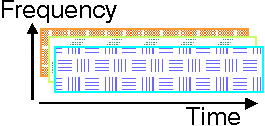
Spread Spectrum Transmission
In Spread Spectrum communication, the bandwidth occupancy of a single transmitted signal is much higher than in systems using conventional modulation methods. This band-spreading is achieved by selecting appropriate transmission waveforms with a wide bandwidth. A very popular method is to
multiply
the user data signal with a fast code sequence, which mostly is independent of the transmitted data message.
In the case that multiple users share the same portion of the radio spectrum but use different codes
to distinguish their transmissions, we speak of Code Division Multiple Access (CDMA)
The ratio between the bandwidth of the user signal and the transmit bandwidth is called the "spreading factor".
Spreading does not affect the performance in 'ideal' channels without interference and without dispersion or fading: As we know the the theory of the matched filter for antipodal signals, the BER in an AWGN channel depends on the signal-to-noise ratio E_b/N_0 but is independent of the exact waveform chosen for transmission.
However, under less ideal circumstances spread spectrum can have advantages.
CDMA Schemes
Various spread-spectrum techniques have been proposed:
Applications of spread spectrum are in
- Military Systems. This is the oldest known application. It is popular for security reasons.
- Positioning Systems. High bandwidth signals allow accurate measurements of propagation delays.
This is used to estimate the the distance to a transmitter. (Note:
the location of a strong spread spectrum can be estimated much more accurately that a that of a narrowband radio emitter. This can be a disadvantage in military applications)
- Cellular radio. It is mainly used to combat dispersion and to provide multiple access.
- Wireless LANs. If conventional modulation would be used frequency management for many coexisting links can be very difficult. Moreover,
narrowband transmission could be impaired by deep local fades.
Further reading
Typical implementation problems are
- How to synchronize to a wideband signal with weak spectral power density?
- How to (optimally) detect a signal in the presence of interference components? (rake receiver, interference cancellation, multi-user detection, array processing)
- How to find the appropriate spreading code? (Code or "key" management)
- Near-far effect and power control. In systems with multiple users, strong nearby transmitters may completely block
weak signals from remote transmitters

Implementation Example for Broadband CDMA
The infopad research project implemented a broadband
CDMA system for downlink transmission, with a monolithic radio receiver.
The rake filtering is done at base band.







